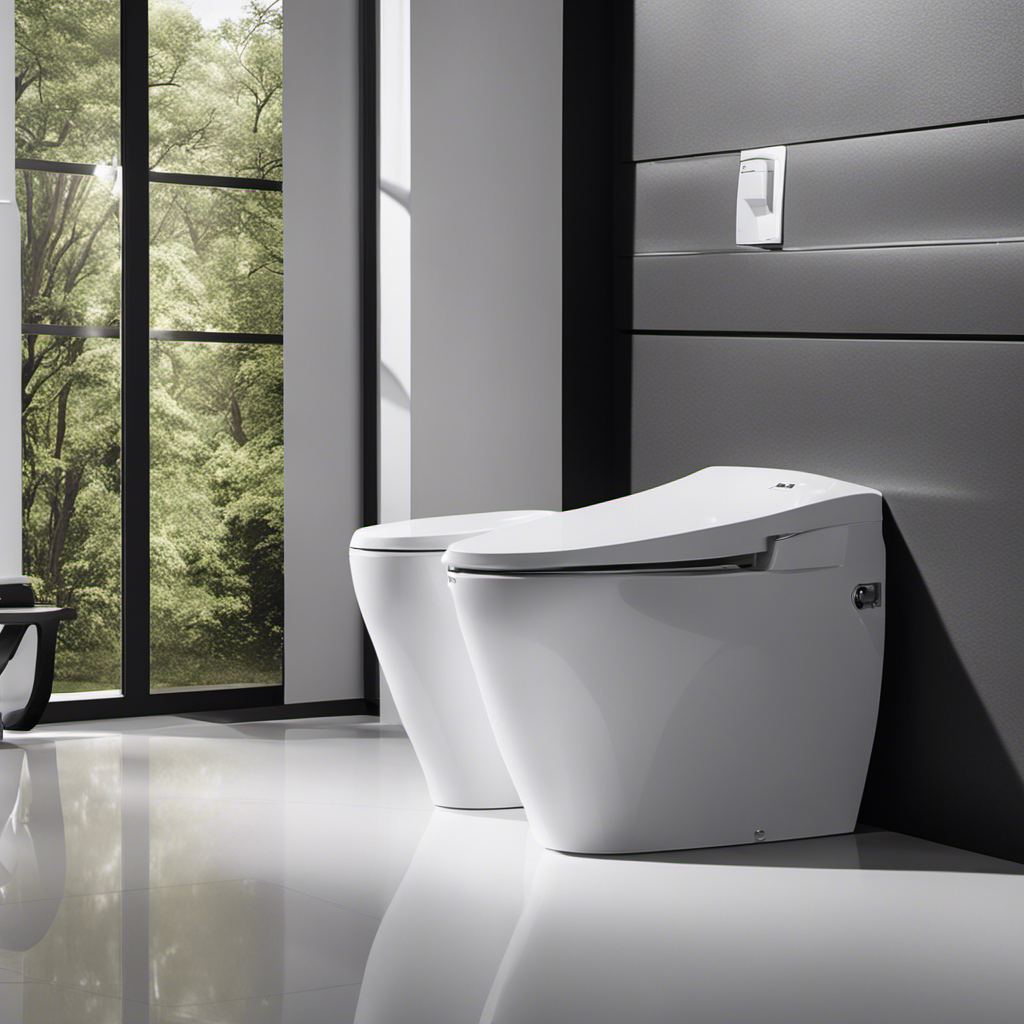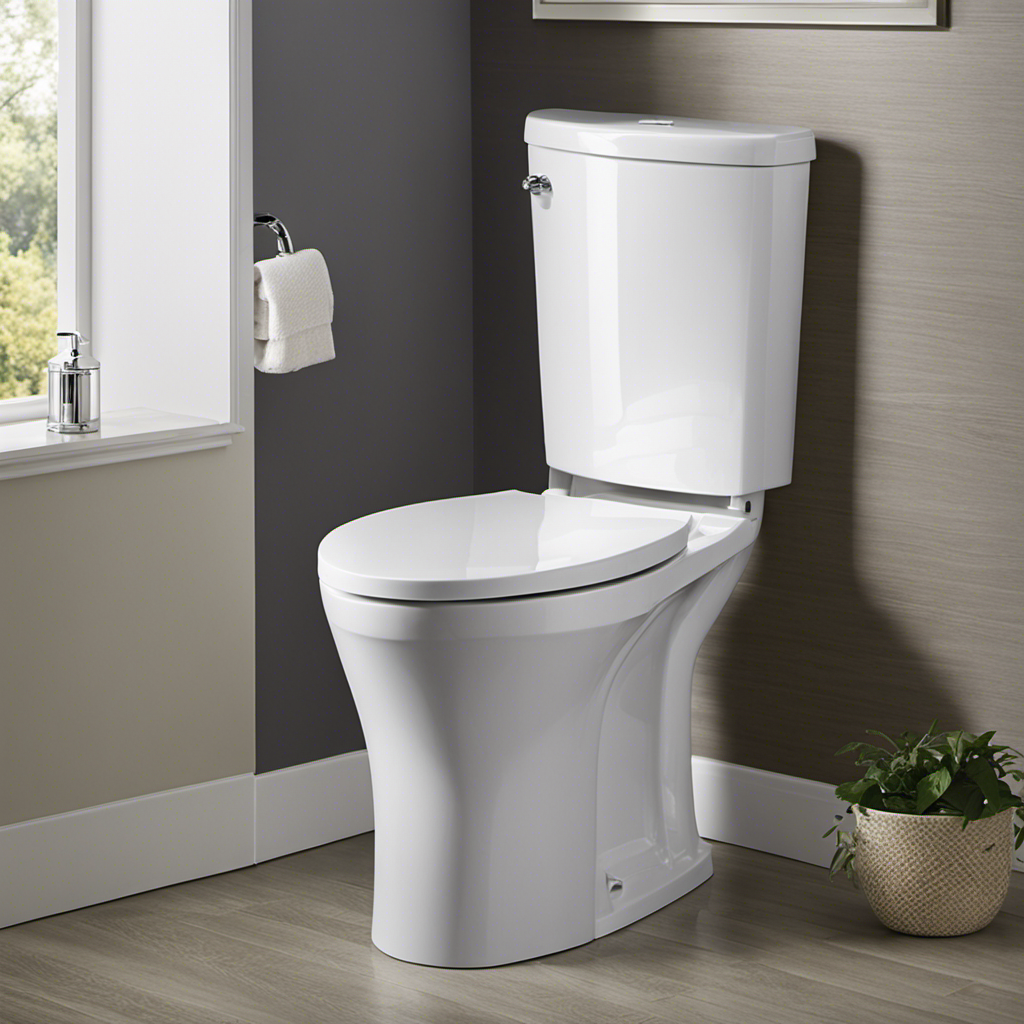When it comes to choosing a toilet, the flush type is a crucial factor to consider. That’s why I’m here to provide you with the ultimate toilet comparison between single and dual flush toilets.
Single flush toilets may be simpler, but dual flush toilets offer significant water savings, reducing usage by 20 to 60 percent. While dual flush toilets may cost more upfront, they can save you money in the long run.
In this article, we’ll delve into the water efficiency, cost, functionality, environmental impact, design options, and ADA compliance of both types of toilets.
Get ready to find out which flush type reigns supreme!
Key Takeaways
- Single flush toilets use the same amount of water regardless of the waste size, while dual flush toilets allow users to choose water usage based on waste load.
- Dual flush toilets save more money in the long run through reduced water bills, while single flush toilets can be more expensive over time due to higher water usage.
- Dual flush toilets are more environmentally friendly, reducing water usage by 20 to 60 percent compared to single flush toilets.
- Both single and dual flush toilets come in various designs and finishes, allowing users to choose a style that suits their preferences.
Water Efficiency Battle: Comparing Single and Dual Flush Toilets
I’ve learned that dual flush toilets are more water efficient compared to single flush toilets, allowing users to choose the amount of water based on the waste load. In a water usage comparison, dual flush toilets come out on top.
They offer two options for flushing: a smaller flush for liquid waste and a larger flush for solid waste. This flexibility allows for significant water savings, as you only use the necessary amount of water for each flush.
When it comes to maintenance and repair costs, single flush toilets may have an advantage. They have fewer parts and are generally easier to fix in case of any issues.
However, considering the long-term benefits of water savings and reduced bills, the slightly higher maintenance and repair costs of dual flush toilets are worth it.
Cost Showdown: Analyzing the Financial Impact of Single Vs Dual Flush Toilets
The cost difference between single and dual flush toilets can have a significant impact on long-term savings. When considering the financial impact, it is important to take into account both the installation costs and water bill savings.
In terms of installation costs, single flush toilets are generally less expensive to install compared to dual flush toilets. This is because single flush toilets have a simpler design and require fewer components. On the other hand, dual flush toilets may require additional plumbing work and a more complex installation process, which can increase the upfront costs.
However, when it comes to water bill savings, dual flush toilets are the clear winner. Dual flush toilets allow users to choose between a full flush for solid waste and a reduced flush for liquid waste. This water-saving feature can significantly reduce water consumption and result in substantial savings on monthly water bills.
Functionality Face-off: Examining the Performance of Single and Dual Flush Toilets
When it comes to how well they work, I’ve found that single and dual flush toilets have distinct differences in their performance.
In terms of performance comparison, single flush toilets use the same amount of water for every flush, regardless of the waste load. On the other hand, dual flush toilets offer two options: a larger flush for solid waste and a smaller flush for liquid waste.
This water usage analysis shows that dual flush toilets are more efficient in terms of water conservation. By allowing users to choose the appropriate amount of water for each flush, dual flush toilets can reduce water usage by up to 60%. This not only saves water but also contributes to environmental sustainability.
Overall, the performance of dual flush toilets surpasses that of single flush toilets in terms of water efficiency and waste management.
Environmental Impact: Evaluating the Sustainability of Single and Dual Flush Toilets
In terms of environmental impact, it’s important to evaluate the sustainability of single and dual flush toilets. When considering the water conservation benefits and long term cost analysis, here are three key points to consider:
-
Water Efficiency: Dual flush toilets are designed to save water by offering users the option to choose between a full flush or a half flush, depending on the waste load. This flexibility allows for significant water savings compared to single flush toilets, which use the same amount of water for every flush.
-
Financial Savings: While dual flush toilets may have a higher upfront cost, their water-saving capabilities can lead to long term financial savings. By reducing water usage, dual flush toilets help lower water bills over time, making them a more cost-effective choice.
-
Environmental Sustainability: Dual flush toilets contribute to environmental sustainability by conserving water resources. With the ability to reduce water usage by 20 to 60 percent, these toilets play a crucial role in water conservation efforts and help mitigate the strain on freshwater sources.
Design Dilemma: Choosing Between Single and Dual Flush Toilets
I’m faced with a design dilemma as I choose between a single or dual flush toilet.
In terms of aesthetics evaluation, both single and dual flush toilets come in a variety of designs, finishes, and colors to match any bathroom decor.
However, when it comes to user experience analysis, there are some key differences to consider. Single flush toilets have a simple lever or button that releases a fixed amount of water with each flush, regardless of waste load. This can lead to issues with clogs if too much waste is flushed at once.
On the other hand, dual flush toilets offer more control by allowing users to choose between a larger flush for solid waste and a smaller flush for liquid waste. This can enhance ease of use and comfort, as users can adjust the water usage based on their needs.
Ultimately, the choice between a single or dual flush toilet will depend on individual preferences and priorities.
Accessibility Considerations: Exploring ADA Compliance in Single and Dual Flush Toilets
For accessibility considerations, it’s important to explore the ADA compliance of both single and dual flush toilets. When it comes to public restrooms, ADA compliance ensures that individuals with disabilities can use the facilities comfortably and safely.
Dual flush toilets offer several benefits for the elderly and disabled, making them a great option for ADA-compliant restrooms:
-
Ease of Use: Dual flush toilets typically have larger buttons or levers that are easier to grasp and operate, making them more accessible for individuals with limited dexterity or strength.
-
Water Conservation: Dual flush toilets allow users to choose between a full flush and a half flush, which uses less water. This not only saves water but also reduces the strain on individuals who may have difficulty flushing a traditional toilet.
-
Cost Savings: By using less water, dual flush toilets can help reduce water bills, making them a cost-effective choice for public restrooms.
Overall, the ADA compliance of both single and dual flush toilets is essential for ensuring equal access for all individuals. However, the benefits of dual flush toilets, such as ease of use, water conservation, and cost savings, make them a particularly attractive option for the elderly and disabled.
The Ultimate Verdict: Which Flush Type Reigns Supreme in the Toilet Comparison?
Based on the factors of accessibility, water conservation, and cost savings, it is clear that dual flush toilets reign supreme in the ultimate verdict of this toilet comparison.
When it comes to water usage comparison, dual flush toilets outperform single flush toilets by allowing users to choose the amount of water they need based on the waste load. This results in significant water savings, with dual flush toilets reducing water usage by 20 to 60 percent compared to single flush toilets.
In terms of maintenance and repair costs, single flush toilets may seem more convenient due to fewer parts, but they can be more expensive in the long run as they require more water per flush.
Frequently Asked Questions
Are There Any Disadvantages to Using a Dual Flush Toilet?
There are a few disadvantages to using a dual flush toilet. Compared to single flush toilets, dual flush toilets can be more expensive upfront and may require more maintenance due to their more complex design. However, they do offer water-saving benefits.
Can Dual Flush Toilets Be Easily Converted to Single Flush Toilets?
Converting dual flush toilets to single flush is like trading in a fuel-efficient hybrid car for a gas-guzzling SUV. Single flush toilets offer simplicity, cost savings, and less water usage, making them a practical choice.
Do Single Flush Toilets Have Any Water-Saving Features?
Yes, single flush toilets can have water-saving features such as an anti-jam feature that prevents clogs and allows only small amounts of waste into the bowl at one time. However, the benefits of dual flush toilets outweigh those of single flush toilets in terms of water conservation.
Are There Any Specific Maintenance Requirements for Dual Flush Toilets?
Maintaining a dual flush toilet requires specific care, such as regular cleaning, checking for leaks, and ensuring proper functioning of the buttons or lever. However, the benefits of water conservation and cost savings make it worth the effort.
What Are the Available Options for Customizing the Design of a Single Flush Toilet?
When customizing a single flush toilet, options include choosing from various designs, finishes, and colors. However, it’s important to consider the pros and cons of dual flush toilets, which offer water-saving benefits and reduced environmental impact.
Conclusion
In conclusion, the battle between single and dual flush toilets has revealed a clear victor.
Symbolically, the dual flush toilet reigns supreme, representing a more sustainable and cost-effective choice. With its ability to reduce water usage by up to 60%, the dual flush toilet symbolizes our commitment to preserving our precious resources.
Additionally, its long-term financial benefits cannot be ignored, making it a wise investment.
While single flush toilets may have their advantages, the dual flush toilet emerges as the ultimate champion in this ultimate toilet comparison.










